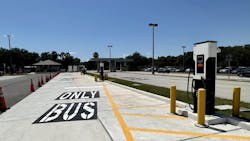Tampa International Airport [TPA] is furthering their commitment to sustainability with the integration of four BYD K9M 40-foot electric buses to transport workers.
Tampa International Airport Senior Manager of Communications Josh Gillin said the buses went into service on May 15.
“These buses are being used to transport workers for our vendors and our partner businesses at the airport and currently they have to park at an employee lot. So, these are being used as shuttles to bring the employees from the employee lot to the main terminal over at the airport,” Gillin said. “They will bring them to the main terminal and then they can go out to whatever business they work at any of our air sides. So, the idea here was we have a circuit of buses that run continuously 24 hours a day, seven days a week, and we had a fleet of seven diesel buses.”
The Hillsborough County Aviation Authority, which operates TPA, won a $4.65 million federal Zero Emission Vehicle Grant to purchase the buses and install the charging stations at the North Employee Parking Lot.
“We were able to apply for a zero emissions vehicle grant to try to make that a little more carbon friendly and cut down on those diesel emissions and use those buses,” Gillin said. “There's four of them now to do that circuit every day. Since they're running, they run 36,000 miles a year. You can imagine that that's a great reduction in fuel costs and in the amount of emissions that we have from that and also to provide those employees with a premium experience, these are top of the line buses and it was just a good opportunity for us to implement these kinds of things in a way that would be meaningful because they were running so often.”
Gillin said TPA is looking to eventually purchase three more electric buses and retire remaining diesel buses still being used to transport employees
BYD K9M Buses
BYD Coach and Bus Director of Sales Jason Yan said the BYD K9M 40-foot model is the most popular electric bus model in the state for public transportation.
“So, this bus comes with over 300 kWh battery operating over 156 miles with the single charge,” Yan said. “… This model is quite suitable for their [TPA] operation and so it's a very typical, low floor shuttle bus, which is very wheelchair-friendly and also the passenger, easy access with the luggage.”
The K9M low-floor electric buses are powered by electricity instead of fossil fuels. The 16-ton buses are handicapped-accessible, equipped with USB chargers, luggage racks and can seat up to 37 passengers.
As part of the project, the airport installed Siemens SICHARGE charging centers with three dispensers in the employee parking lot, where the buses are parked when not in service.
"There is currently capacity for a fourth dispenser in the future," Gillin said.
Why Should Airports Consider Electric Buses?
“More and more airports will start to operate the electric buses. So, several reasons, first of all from the investment standout point, electric buses even the capital investment is relatively higher than the IC buses, which is diesel and CNG,” Yan said. “But if we consider the total ownership, the cost within the next 12 years [for] electric buses is much less than those IC buses. So the fuel cost will be much lower and also the maintenance cost will be much lower because for the electric buses there is less components inside of the bus.”
Yan said less components also means less work and maintenance hours.
“It's easy to be maintained because there's a lot less of the components that the maintenance department from the airport need to spend [time] on,” Yan said. “On the old, the traditional buses like filter change, the oil and check the transmission, all those components are not in the electric buses. So, it will be easier to be made to maintain those electric buses.”
Yan said another bonus with electric buses is that they are much quieter than traditional buses.
“The IC bus and the noise from the engine always bothered me. If I travel with my colleague, I barely can hear inside of the box. But for the electric bus, it’s extremely quiet,” Yan said.
Yan also said the charge time on these model buses will depend on the charger being used, but the average time to charge the bus from zero to 100 percent is about three hours.
What Do Airports Need to Know before Going Electric?
“The infrastructure is the thing [to consider] because right now most of the electric buses are using the higher charging power charger,” Yan said. “So, whether the infrastructure, the switch gear, the converter transformer is ready to go for them to charge the bus at the yard will be the topic they need to discuss before the bus deployment. So, I think that's the homework the airport needs to do before they receive the buses. There is no significant difference operation wise between the traditional bus and the electric buses. I think they will be very easy to adapt. It's better to have the charter ready before the bus is delivered.”
Yan said BYD will work with airports to determine which model bus best fits their needs and what type of charging pads they will need to install.
“So, each project BYD will assist the airport to evaluate which charter is best for them because we need to check with them. What's your operating hours? From what time in the morning and to what time in the evening?” Yan said. “So, we will evaluate that and also check the parking lot where they’re going to park the bus so we can discuss with them whether you need the one charter with two charging ports or you need the one charger for each charter and how much power it will be.”





